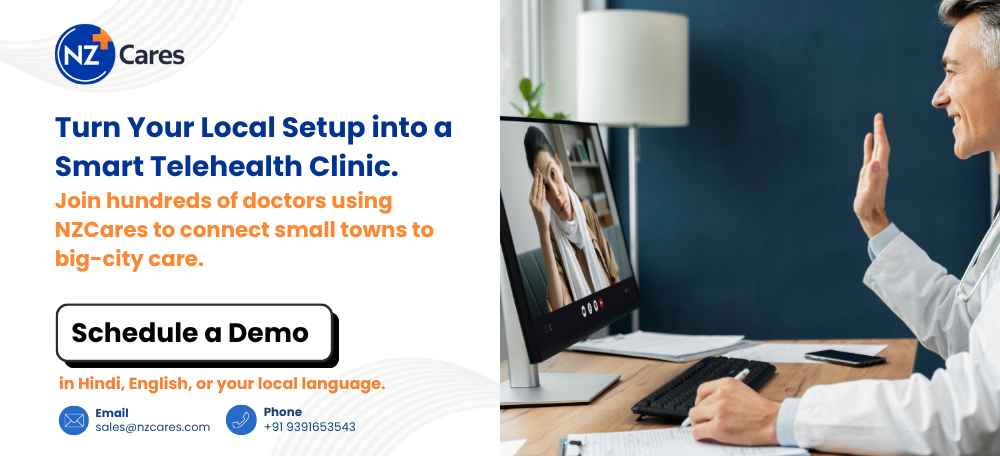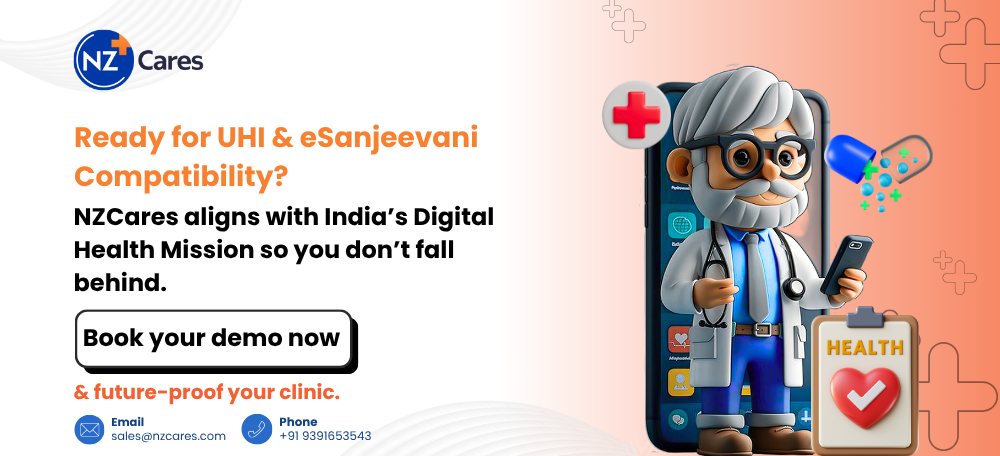India’s government-backed eSanjeevani platform crossed a staggering 140 million consultations in 2024. What began as an emergency pandemic response has now become an essential pillar of India’s healthcare infrastructure. Telemedicine is no longer the future – it’s the norm.

Over the last few years, digital consultations have surged across the country, particularly in Tier 2 and Tier 3 cities, where specialist doctors were often hours or entire districts away. From a mere 1% pre-pandemic, teleconsults soared to nearly 70% in some private networks during COVID. And that upward trend hasn’t slowed down.
But it’s not just about distance anymore.
Today, patients expect that services come to them to get relevant care. They want a mobile first experience and the convenience of contacting doctors from their sofa. So, it is natural they expect telemedicine software to support multiple languages, offer digital prescriptions, protect their health data, and allow them to pay with a tap.
With hundreds of telemedicine providers entering the Indian market, the real differentiator isn’t who looks flashiest, it’s who delivers on the fundamentals.
In this blog, we decode the world of Indian telemedicine and explore eight top telemedicine software features that can boost your hospital’s revenue growth.
India’s Road to Mainstream Telehealth
Not long ago, the idea of video-calling a doctor felt futuristic. But today, it’s fast becoming the default, especially in parts of India where physical access to hospitals remains limited. Telehealth is no longer a backup plan. It’s how care begins.
During early 2019, virtual consultations were mostly DIY as doctor Zoom, WhatsApp, and simple phone to connect. While it was quick, it was inconsistent, glitchy, and lacked critical features.
As COVID spread throughout the country, the digital health landscape changed overnight. The government came up with Telemedicine Practice Guidelines (2020), providing legality to telemedicine. Then came eSanjeevani OPD, which enabled millions of real-time doctor consultations across states and villages.
Private hospitals quickly followed suit. From Apollo to Fortis, and digital-first providers, everyone began integrating telemedicine into their core services. Clinics saw the potential and invested in software to serve patients virtually.
Today, it’s not just video calls anymore. Now, the top telemedicine software has things like EMR integrations, voice dictation, digital prescriptions, UPI-enabled payments, and even AI-led triage.
8 Must-Have Telemedicine Software Features
India’s digital healthcare landscape has evolved rapidly and so have patient expectations. As we saw in the previous section, the early success of platforms wasn’t just about being online. It was about delivering seamless, smart, and secure care at scale. Here are the 8 features every modern platform must include.
1. ABHA & EMR Integration
To make digital health work, patient records need to move smoothly between doctors, labs, and clinics. That’s where ABHA and EMR work together.
ABHA is a 14-digit health ID that connects a person’s health data across hospitals. EMR is where all that data is stored, including tests, prescriptions, reports, etc.
When connected:
- Doctors can check the latest reports without asking patients to resend.
- Patients don’t repeat their health history every time.
- Different clinics can treat one patient with better coordination.
- It’s all part of India’s digital health mission (ABDM), which gives developers the tools and rules to build it right.
2. AI-Powered Smart Triage & Queue Management
AI does two smart things here; it figures out who needs care first, and it keeps the line moving.
Triage is where AI looks at symptoms and decides how serious they are. For example, someone with chest pain gets flagged faster than someone with a sore throat. The AI can even tell the patient if they should visit a doctor, call emergency, or try home care.
Then comes queue management. The system places patients in line, reshuffles when needed, and avoids long wait times.
Useful parts:
- Remote check-ins and live queue tracking
- Auto-rescheduling if doctors are delayed
- Faster care for high-risk cases
It’s how busy clinics manage crowds without chaos.
3. Multilingual UI + Voice Input Among top Telemedicine Software Features
Good telemedicine software shouldn’t make people feel lost because of the language barrier.
It works better when the platform is compatible with the user’s language. For example, patients in Kerala can use Malayalam, while someone preferring English can also stick to it, Voice input also helps. Some users can’t type or just prefer to speak.
This feature is useful for:
- Elderly patients who don’t use smartphones often
- Doctors taking quick notes while consulting
- Translating live conversations between two languages
Telemedicine software features like that are essential for reaching everyone.
4. ePharmacy + ePayment Integration
Once the consultation ends, patients want two things: medicine and a way to pay. If the platform handles both, the experience will feel complete.
With ePharmacy:
- Prescriptions go directly to partnered pharmacies
- Patients get medicine delivered without stepping out
- No chance of losing paper prescriptions
With ePayments:
- Patients can pay online with UPI, cards, wallets
- Billing happens instantly, no manual follow-ups
- Everything stays secure through certified gateways
5. Role-Based Access + Reporting Dashboards
You already wear 5 hats. You should not have to juggle software too. NZCares simplifies your day with this telemedicine software features:
- New patients pre-fill their data via WhatsApp
- Billing and prescriptions take seconds
- Follow-ups get automated reminders
- And your entire practice runs from your phone
It is low-cost, easy to use, and yes—your patients will notice the difference.
6. Customization Capabilities
Every clinic works in its own way. A dermatology chain doesn’t need the same flow as a physiotherapy center.
That’s why platforms must allow:
- Changing app name, logo, and color
- Adding only needed features, like second opinions or diet tracking
- Re-arranging buttons or labels for easy use
- Plugging in tools made just for their specialty
7. Cross-Platform Support
Patients want peace and do care about the device support as they don’t want to get stuck and get a different device just to book an appointment.
A telemedicine software should:
- Works on iOS, Android, Windows, macOS
- Let’s users switch between devices without losing progress
- Runs even on low-speed networks
Doctors on laptops and patients on mobile are easily possible without telemedicine software providers.
8. Smart Notifications
Forgetfulness is a major reason for poor treatment adherence. Smart notifications in telemedicine platforms solve this by gently reminding users about important health events.
Simple notification like:
- “Your appointment is in 30 minutes”
- “Time to refill your medicine”
- “Check your blood sugar today”
These notifications reduce missed appointments and improve long-term care. Patients can pick how they get them, such as SMS, push alerts, or email. And when.
Read More: EHR Adoption in Hospitals Doesn’t Have to Be Hard: 5 Ways to Make the Shift Seamless
Types of Care That Thrive on Telehealth Software
Telemedicine is more than just a fix for seasonal flu. It’s now a full care model that reaches from first symptoms to long-term recovery. With the right telemedicine software, several health conditions can be managed right from home.
- Acute Conditions: Telemedicine software is often used as a first stop if someone catches a fever or in any body pain. They can make a quick call and get a prescription all within a minute with it.
- Chronic Illnesses: Hospital beds are not always necessary for patients with diabetes, heart issues, or high BP. They can just connect with the top related doctors on telemedicine platforms, and can send updates, check vitals, and adjust medicines.
- Medication & Recovery Tracking: Doctors follow up without hospital visits. Post-surgery wounds, dosage changes, and regular health tips handled right from your screen.
- Mental Health Support: Anxiety, stress, or long phases of low mood, getting help from home lowers the barrier. No waiting rooms, no travel. Just a private screen and a professional ready to listen.
- Rehab & Therapy Sessions: Physical therapy or speech recovery often needs regular nudges. Therapists guide, observe, and update routines. Patients save travel but not progress.
Read More: Reimagining Primary Health Care in India: The Role of AI, Digital Innovation, and NZCares
How India Is Making Telemedicine Inclusive and Scalable
India isn’t waiting on future solutions. It’s already reshaping healthcare through telemedicine, town by town. What started as video calls is now turning into a nationwide grid powered by digital tools and strong public-private backing.
At the center is eSanjeevani OPD, India’s biggest public health teleconsultation platform. It now lives in over 30 states, connecting patients to doctors across rural clinics and government hospitals. It is a growing lifeline in smaller towns.
Then there’s ABDM, which powers the Unified Health Interface (UHI). It lays down the foundation for portable health records and connected care journeys—making it easier for every clinic to offer the best EMR software for single doctors. The idea is one ID, one record, accessible anywhere and it is among the top telemedicine software features.
IRDAI’s green light on insurance for teleconsults is another leap. Now private plans cover video consultations too. That means more people opt in without worrying about payment hassles.
Even solo-run clinics in remote pockets now use top telemedicine software to reach patients, monitor care, and grow their practice. NZcares, with its patient-first design and all-in-one workflows, is leading that change quietly but impactfully.
Making Telehealth Accessible with AI-Powered NZCares Platform
More than just another tool, NZCares is a complete telemedicine platform built for today’s digital-first care needs. From hospitals to solo clinics, it blends smoothly into existing systems and keeps the focus on where it belongs, which is on the patient. Simple to use, packed with smart telemedicine software features, and built to scale, NZCares turns tech into real-world impact.
- Appointment Scheduling: Patients see when doctors are free. Book video or audio calls fast. Get care without hassle.
- Medical Records Access: Safe access to health records. See lab results or prescriptions anytime. Keep care on track.
- Medication Reminders: Push alerts remind patients to take meds. Helps them stay healthy.
- User-Friendly Interface: Clean design. Works even for users who don’t know tech well.
- Multi-Language Support: Care doesn’t stop at English. Local languages make it easy for all.
- Interoperability: Fits with current EHR systems. Ties telemedicine platform to hospital tasks which keep work streamlined.
- Analytics and Reporting: Automatic reports show patient and system data which helps doctors make smart choices.
This kind of all-in-one telemedicine software changes how care is delivered.
Read More: NZCares: Bring India’s Best AI Hospital Management System
Data-Backed Benefits: Pre and Post Telemedicine Software Adoption
Switching to top telemedicine software is about the features and the results they provide to your facility. Here’s what clinics are seeing before and after adopting a smart, AI-supported system:
| Metric | Before Telemedicine | After NZCares Telehealth Software Platform |
| Avg. Patient Wait Time | 45–60 mins | Under 15 mins |
| No-show Rate | 25–30% | Below 8% |
| Consultation Volume/Day | ~15 | 30–50 (async + parallel slots) |
| Patient Satisfaction | Unmeasured | Measured with excellent feedback |
| Staff Load (Admin Tasks) | High | 50% lower with automation |
| Access to Care (Tier 2/3) | Patchy and error prone | Seamless via mobile |
To Sum Up the Top Telemedicine Software Features
Digital care is no longer limited to metro cities. Patients across towns and smaller cities now expect smooth, app-based consultations. For them, switching between booking, talking to a doctor, and paying. It should all feel like one single step.
For clinics, this shift is both a challenge and a chance. The right telemedicine software platform helps with online consultations. From reports to reminders, from e-pharmacy to follow-ups, good software takes the pressure off doctors and puts focus back on care.
Our telemedicine software features make this easier. With smart tools built around patient needs, it becomes more than just a feature-rich app. It becomes a partner. Clinics using the best EMR for telemedicine stand out, especially when they are equipped with NZCares.
To learn how NZCares can transform your practice, visit www.nzcares.com/telemedicine-software-development or email us at sales@nzcares.com.

